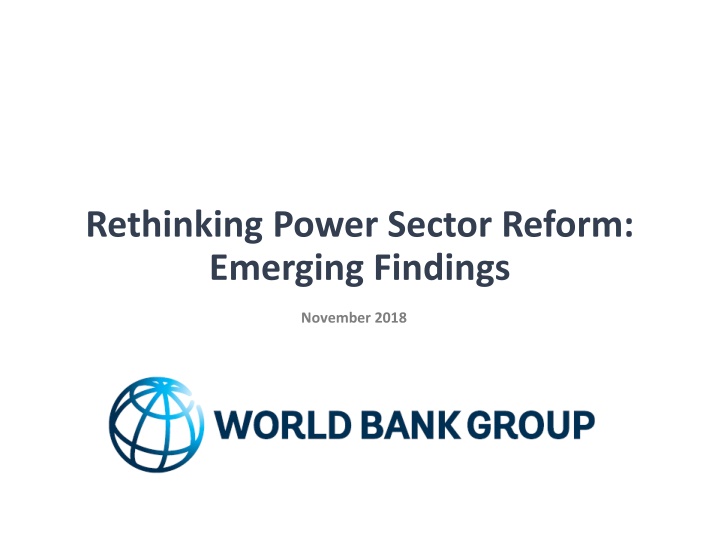Evolution of Power Sector Organization: A Historical Perspective
The evolution of power sector organization from the 1870s to the present day reflects significant shifts in regulation, privatization, liberalization, and restructuring. The standard power sector reform model of the 1990s, characterized by 5Rs - restructure, privatize, regulate, liberalize, and recover costs, has seen varied adoption globally. This analysis highlights the geographic, income group, and system size variations in the uptake of power sector reforms.
Download Presentation

Please find below an Image/Link to download the presentation.
The content on the website is provided AS IS for your information and personal use only. It may not be sold, licensed, or shared on other websites without obtaining consent from the author.If you encounter any issues during the download, it is possible that the publisher has removed the file from their server.
You are allowed to download the files provided on this website for personal or commercial use, subject to the condition that they are used lawfully. All files are the property of their respective owners.
The content on the website is provided AS IS for your information and personal use only. It may not be sold, licensed, or shared on other websites without obtaining consent from the author.
E N D
Presentation Transcript
Rethinking Power Sector Reform: Emerging Findings November 2018
25 Years of the Standard Power Sector Reform Model 2
Thinking on power sector organization has Thinking on power sector organization has gone through a historical evolution gone through a historical evolution 1870s-1920s: electricity was an unregulated, elite, and mostly private good 1920s-60s: as electricity became a mass public good, states took control making utilities public monopolies 1970-80s: market-oriented power sector reforms began as experiments based in large part on economic theory 1990s: market-oriented reforms became global norm, and were widely supported by development partners 2000s: some government intervention re-emerging in response to perceived limitations and new policy agenda 3
The 1990s standard reform model The 1990s standard reform model can be characterized in terms of 5Rs can be characterized in terms of 5Rs RESTRUCTURE PRIVATIZE REGULATE LIBERALIZE RECOVER COSTS 4
By 2015, we see wide geographic variation By 2015, we see wide geographic variation in uptake of standard reform model in uptake of standard reform model World Map of Power Sector Reform Index, 2015 Index of 0-100 captures adoption of structural reforms at country level: restructuring; liberalization; regulation; and privatization
Many countries are in categories that have Many countries are in categories that have had limited uptake of reform had limited uptake of reform Power Sector Reform Index 100 100 By Income Group 90 80 By Geographic Region (1995-2015) 90 70 80 60 50 70 40 30 60 20 10 50 0 Low income Low income Lower middle Upper middle Lower middle incomeUpper middle income 40 100 90 30 By System Size 80 70 20 60 10 50 40 0 30 1995 1996 1997 1998 1999 2000 2001 2002 2003 2004 2005 2006 2007 2008 2009 2010 2011 2012 2013 2014 2015 20 10 East Asia & Pacific Europe & Central Asia Latin America & Caribbean Middle East & North Africa South Asia Sub-Saharan Africa East Asia & Pacific Europe & Central Asia Latin America & Caribbean 0 Middle East & North Africa South Asia Sub-Saharan Africa <1GW 1-10 GW >10 GW <1GW 1-10 GW >10 GW
Moreover, significant gaps arose between Moreover, significant gaps arose between reforms announced and implemented reforms announced and implemented Regulation Restructuring Competition PSP Announced Reforms 100 80 60 40 20 0
Power markets are still only relevant to Power markets are still only relevant to a relatively small subset of countries a relatively small subset of countries Power markets exist in only 20% of developing countries Most countries don t meet basic readiness conditions (size >3GW or $1bn, sector structure, cost recovery) Regional markets may offer a useful alternative for smaller systems Some kind of transition process towards a competitive market is often required, but pose risks of remaining stuck in the transition Cost based pools may offer a good start where concerns about market power Single-buyer model seems attractive but may lock-in rigid PPAs slowing transition Diffusion of liberalization reforms in developing countries
Power markets offer reliability but require Power markets offer reliability but require a comprehensive approach a comprehensive approach Implementation calls for continuous monitoring, learning and adjustment Even in larger markets, market concentration and vertical integration continue to pose significant barriers Short term markets will not provide basis for investment, but should focus on efficient allocation of available power For long-term investments, markets need to provide stable revenue sources, with auctions for long term contracts being increasingly popular 9
Generation Generation 10
And 70+ private sector transactions were And 70+ private sector transactions were cancelled, with highest risk being in Africa cancelled, with highest risk being in Africa Cancellation Rate for Private Sector Participation in the Power Sector 1990-2017 70% PSP cancellations (1990-2017) Distribution (SSA) 7 60% 50% 40% IPPs (ROW) 35 Distribution (ROW) 25 30% 20% 10% IPPs (SSA) 4 0% IPPs Total Distribution Divestment Concession Management SSA Rest of the world Source: World Bank PPIAF: Private Participation in Infrastructure Database, 2018 While IPPs account for a higher absolute number of cancelled transactions, cancellations in distribution are much higher as a percentage of the total instances of PSP
What we care about is whether countries What we care about is whether countries improved power sector performance improved power sector performance 1. Security of Supply Reserve margin, plant load factor, capacity expansion 2.Efficiency Value of distribution and collection losses 3.Cost Recovery Ratio of average revenue to full cost recovery benchmark Security of Supply Cost recovery Access and Affordability Environment Sustainability Efficiency Colombia Peru Ukraine Vietnam Philippines Kenya India Morocco Egypt 4.Access & Affordability Electrification rate and budget share of bill 5.Environmental Sustainability Carbon intensity of power (1990-2014) Tajikistan Pakistan Uganda Dominican Republic Senegal Tanzania 12
IPPs were among the most widely IPPs were among the most widely adopted power sector reform adopted power sector reform As of 2015, 70% of developing countries had opened their markets to IPPs; most popular power sector reform after establishing a regulator Since 1990, private sector invested a cumulative total of $587bn and installed capacity of 494 GW, concentrated in a handful of countries Investment in IPPs has been cyclical peaking in 2012 at $70bn and currently enjoying a renewed upswing driven by wind and solar energy 70000 60000 Investments (Mn $) 50000 India, 22% 40000 Rest of the developing world, 43% 30000 57% Brazil, 17% 20000 China, 8% 10000 Turkey, 5% Indonesia, 5% 0 1990 1991 1992 1993 1994 1995 1996 1997 1998 1999 2000 2001 2002 2003 2004 2005 2006 2007 2008 2009 2010 2011 2012 2013 2014 2015 2016 2017 Coal Natural gas Oil Hydro Gethermal Wind Solar Biomass 13 Source: World Bank PPIAF: Private Participation in Infrastructure Database, 2017
Nevertheless, IPPs still coexist with new Nevertheless, IPPs still coexist with new public generation projects in most countries public generation projects in most countries IPPs as % of total added capacity, by region (1990-2016) IPPs Public 100% 80% 60% 40% 20% 0% East Asia and Pacific Middle East and North Africa Sub-Saharan Africa South Asia Latin America and the Caribbean Europe and Central Asia 0%-25% 25%-50% 50%-75% 75%-100% % of IPP in added capacity (1990-2016) IPPs contributed about 23% of generation capacity expansion in the developing world during the period 1990-2016 Capital flows to Sub-Saharan Africa were small in absolute terms (just $30bn or 5% of global total), yet critical (providing 34% of new capacity) In some countries policy enthusiasm for IPPs has waxed and waned due to various difficulties that have been encountered 14
Lack of competitive procurement has Lack of competitive procurement has often led to controversy around IPPs often led to controversy around IPPs Procurement of IPPs, by region (2005-2017) Tanzania IPP controversies 100% 80% IPTL PROJECT In 1993, IPTL unsolicited bid presented as emergency supply to diversify generation Corruption allegations accompanied the direct procurement of the project Led to rift with donors and financial losses due to expensive diesel based power RICHMOND PROJECT In 2006, during another crisis Richmond development company awarded 100MW EPP Company lacked any power sector expertise Project was delayed, providing electricity only after supply crisis was over Corruption investigation led to resignation of PM and line minister 60% 40% 20% 0% East Asia and Pacific Europe and Central Asia Latin America and the Caribbean Middle East and North Africa South Asia Sub-Saharan Africa Competetive IPPs Merchant plants Direct negotiation - IPPs Not available IPPs have not always been procured by competitive means, raising concerns about transparency and value for money Several countries experience high profile conflicts around procurement of specific projects (e.g. India, Senegal, Tanzania, Uganda) 15
Standard reforms too often overlooked Standard reforms too often overlooked the critical issue of system planning the critical issue of system planning 1990s reform model, did not adequately emphasize planning and institutional capacity for this critical function sometimes fell between the cracks In the absence of sound planning and procurement frameworks, adoption of IPP reforms alone are unlikely to deliver on security of supply objectives Countries that are keeping pace between capacity expansion and peak demand growth tend to perform better on both generation and transmission planning Are direct negotiations allowed for entry of new generation? Is there a framework for procurement of new transmission lines? Are ICB or public auctions allowed for entry of new generation? Is generation planning transparent and participatory? Is transmission planning transparent and participatory? Is planning entity overseen by inter-governmental committee? Is generation plan mandatory rather than indicative? Is transmission plan mandatory rather than indicative? Are public auctions used for power generation? 0% 50% 100% 0% 20% 40% 60% 80% 100% 16 Not keeping pace Keeping pace Not keeping pace Keeping pace
Distribution Distribution 17
The case for sector unbundling needs The case for sector unbundling needs to be carefully considered to be carefully considered Unbundling of vertically integrated incumbent power utilities by itself is unlikely to deliver major benefits, and mainly relevant to larger systems >1GW There are both challenges as well as benefits associated with unbundling Benefits Paves way for power market or PSP Increases transparency and accountability Challenges Involves significant transactions costs to separate accounts, assets, human resources, power flows, governance arrangements Spreads limited managerial capacity more thinly Exacerbates any lack of payment discipline along the supply chain Diffusion of unbundling reforms in developing countries 18
While PSP can boost utility efficiency, While PSP can boost utility efficiency, there is no guarantee of immediate results there is no guarantee of immediate results Karachi Electric % Revenue lost due to distribution losses % Revenue lost due to collection rate % Revenue lost due to inefficiencies Average Tariffs LCU Index Average Tariffs USD Index 35.00% 700% Average Tariff Indices 30.00% 600% 25.00% 500% 20.00% 400% 15.00% 300% 10.00% 200% 5.00% 0.00% 100% UMEME APSPDCL 35.00% 700% 35.00% 700% 30.00% 30.00% 600% 600% 25.00% 25.00% 500% 500% 20.00% 20.00% 400% 400% 15.00% 15.00% 300% 300% 10.00% 10.00% 200% 200% 5.00% 5.00% 0.00% 100% 0.00% 100% 2005 2006 2007 2008 2009 2010 2011 2012 2013 2014 2015 2002 2003 2004 2005 2006 2007 2008 2009 2010 2011 2012 2013 2014 2015 19
Good governance practices available Good governance practices available to both public and private companies to both public and private companies Adoption of HR Practices Adoption of IT systems Adoption of Accounting Practices Adoption of Board Practices 20
Regulators are widespread, but they are Regulators are widespread, but they are rarely as good in practice as on paper rarely as good in practice as on paper About 70% of developing countries have created independent regulators , making this the most popular of all the standard reforms Some evidence regulators contributed to good sector outcomes, particularly in Middle Income Countries and where utilities have been privatized But, many regulators primarily oversee state-owned utilities with more limited impact While the legal and regulatory framework often looks to be quite well designed, de facto regulatory practice tend to diverges substantially from the de jure framework Country Scores on Index of Regulatory Good Practice 100% 83% 82% 78% 78% 77% 74% 72% 80% 66% 68% 68% 61% 66% 63% 61% 60% 60% 53% 60% 48% 45% 38% 38% 37% 34% 40% 31% 30% 25% 20% 0% Tajikistan Vietnam Morocco Colombia Ukraine Kenya Philippines India Tanzania DR Egypt Pakistan Peru De Jure De Facto
Regulators are more accountable than Regulators are more accountable than autonomous, and put most focus on tariffs autonomous, and put most focus on tariffs Regulators struggle to achieve autonomy while they do seem to be held accountable for their decisions (ironically!) Most tariff regulation regimes combine a mixture of price cap and rate of return elements Quality of service regulation is relatively under-developed and rarely is it effectively enforced While regulators control market entry through licensing, they are not always involved in approval of Power Purchase Agreements Regulatory good practices De Facto De Jure 50% Market Entry Regulation 71% 51% Quality Regulation 78% 62% Tariff Regulation 76% 63% Autonomy 68% 70% Accountability 80% 0% 20% 40% 60% 80% 100% 23
As for tariff structures, cross As for tariff structures, cross- -subsidies to benefit residential customers are prevalent benefit residential customers are prevalent subsidies to Comparison of Average Effective Electricity Tariff Across Customer Categories (US$/kWh) Histogram of Residential, Commercial and Industrial Average Effective Electricity Tariffs (US$/kWh) 35% Percentage of countries 30% Industrial 25% 20% 15% Commercial 10% 5% 0% Residential Residential Commercial Industrial 0.00 0.05 0.10 0.15 0.20 24
Due to technological disruption, future Due to technological disruption, future may look quite different from the past may look quite different from the past Issue Implications Power markets Centralized wholesale markets face zero marginal cost Decentralized markets feasible at distribution tier Sector structure Pressure for unbundling of distribution and retail activities Growing fringe of new entrants reshaping sector Utility business model Utilities may suffer from grid defection but could evolve in one of two possible directions: Reduced to Distribution System Operator role only Integrate decentralized technologies into service offering Regulatory regimes Need for revenue cap controls that uncouple utility revenues from physical sales of electricity to provide, as well as structures that promote innovation by blurring opex/capex distinction Incentives for energy efficiency Revenue protection to maintain grid back-up service Electricity prices Greater need for tariff structures to reflect cost structures by rebalancing towards fixed or capacity related costs to avoid over-incentivizing rooftop solar Greater need for Time of Use pricing to allow stronger participation of demand-side Social policy Distributed generation (likely pro-rich) undermines basis for cross-subsidy between customers























